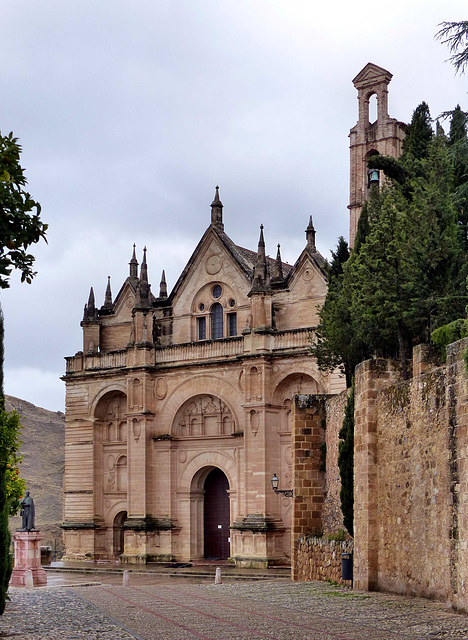Antequera - Santa María de Jesús
Antequera - Real Colegiata de San Sebastián
Parador de Antequera
Parador de Antequera
Córdoba - Guadalquivir
Córdoba - Puente Romano
Córdoba - Mezquita-Catedral
Córdoba - Mezquita-Catedral
Córdoba - Mezquita-Catedral
Córdoba - Mezquita-Catedral
Córdoba - Mezquita-Catedral
Córdoba - Mezquita-Catedral
Córdoba - Mezquita-Catedral
Córdoba - Mezquita-Catedral
Córdoba - Mezquita-Catedral
Córdoba - Mezquita-Catedral
Córdoba - Mezquita-Catedral
Córdoba - Mezquita-Catedral
Córdoba - Mezquita-Catedral
Córdoba - Mezquita-Catedral
Córdoba - Mezquita-Catedral
Córdoba - Mezquita-Catedral
Córdoba - Mezquita-Catedral
Antequera
Antequera - Alcazaba
Ronda - Palacio de Salvatierra
Ronda - Palacio de Salvatierra
Ronda - Palacio de Salvatierra
Ronda - Puente San Miguel
Ronda - Nuestro Padre Jesús
Ronda - Puente Viejo
Ronda - San Sebastian
Ronda - Casa del Rey Moro
Ronda - Casa del Rey Moro
Ronda - Casa del Rey Moro
Ronda - Casa del Rey Moro
Ronda - Casa del Rey Moro
Ronda - Santa Maria la Mayor
Ronda - Puente Nuevo
Ronda - Puente Nuevo
Ronda - Plaza de Toros
Ronda
Ronda
Ronda - Tajo de Ronda
Ronda - Parador
Location
Lat, Lng:
You can copy the above to your favourite mapping app.
Address: unknown
You can copy the above to your favourite mapping app.
Address: unknown
See also...
See more...Keywords
Authorizations, license
-
Visible by: Everyone -
All rights reserved
-
200 visits
Antequera - Real Colegiata de Santa Maria


Antequera was known during Roman times as "Anticaria" and had existed already centuries, when the Romans took over the area from the Carthaginians after the Punic Wars. During the fall of the Roman Empire, the area fell to the Vandals in the 410s. They were attacked by the Visigoths, who incarporated it into the Visigothic Kingdom.
During the Arab invasion Anticaria was conquered around 716 and, when the Reconquista rolled south, it became one of the northern cities of the remaining Nasrid kingdom of Granada. Fortifications were built and a Moorish castle, named Alcazaba, erected. For about two hundred years the Medina, located inside the Alcazaba, was attacked repeatedly. In 1410, an army led by Prince Ferdinand of Aragon conquered it.
Antequera became part of the Kingdom of Castile, the Muslims were driven out. The city became a Catholic fortress against the Nasrid kingdom of Granada, and a base for continuing conquest. After Granada, the last Moorish city, capitulated in 1492, Antequera began to recover from the centuries of fighting.
In 1503 the existing small Iglesia de Santa María de la Esperanza was converted into a into a collegiate church. This church got demolished and the new church, seen today, was completed in 1550.
Seen on the left is a statue of Pedro Espinosa (1578-1650), a poet and writer born in Antequera. He taught here for several years.
During the Arab invasion Anticaria was conquered around 716 and, when the Reconquista rolled south, it became one of the northern cities of the remaining Nasrid kingdom of Granada. Fortifications were built and a Moorish castle, named Alcazaba, erected. For about two hundred years the Medina, located inside the Alcazaba, was attacked repeatedly. In 1410, an army led by Prince Ferdinand of Aragon conquered it.
Antequera became part of the Kingdom of Castile, the Muslims were driven out. The city became a Catholic fortress against the Nasrid kingdom of Granada, and a base for continuing conquest. After Granada, the last Moorish city, capitulated in 1492, Antequera began to recover from the centuries of fighting.
In 1503 the existing small Iglesia de Santa María de la Esperanza was converted into a into a collegiate church. This church got demolished and the new church, seen today, was completed in 1550.
Seen on the left is a statue of Pedro Espinosa (1578-1650), a poet and writer born in Antequera. He taught here for several years.
, Alexander Prolygin have particularly liked this photo
- Keyboard shortcuts:
Jump to top
RSS feed- Latest comments - Subscribe to the comment feeds of this photo
- ipernity © 2007-2025
- Help & Contact
|
Club news
|
About ipernity
|
History |
ipernity Club & Prices |
Guide of good conduct
Donate | Group guidelines | Privacy policy | Terms of use | Statutes | In memoria -
Facebook
Twitter

Sign-in to write a comment.